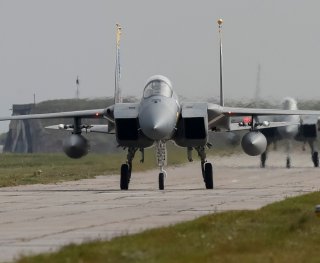Is the Air Force's F-15 Eagle Really Invincible?
It keeps winning big in practice war games.
Key Point: These fighters are top-notch and reliable. They might be aging, but they aren't going away anytime soon.
According to official releases from Boeing and the U.S. Air Force, the F-15 Eagle has a clear-cut win-to-loss ratio of 104 to zero. But in fact, opposing air forces have claimed, in nearly a dozen cases, to have shot down the iconic, twin-engine fighter.
All the claims have one thing in common. The claimants were never able to provide any evidence for their supposed victories.
The earliest report is mostly unknown to the public. Beginning in 1978, Iraqi sources claimed that an Iraqi air force MiG-23MS from No. 39 Squadron shot down an Israeli F-15 over western Iraq. Former Iraqi air force officers have repeated the claim over the years without ever offering any evidence.
The next supposed F-15 shoot-down, from the spring of 1981, is better-known. Several different versions of the story have circulated over the decades, nearly all of them in Russian media.
In the most frequently cited version, on Feb. 13, 1981, Israeli F-15s ambushed a pair of Syrian MiG-25Ps and shot one down. In revenge, so the story goes, the Syrians set up an ambush on June 29, 1981. The Syrian MiG-25Ps destroyed one F-15 using two R-40/AA-6 Acrid air-to-air missiles fired from the range of 25 miles.
There are problems with this story. Neither the Syrians nor the Russians have ever provided any evidence, such as radar tapes or wreckage. Another issue is that the Syrian air force never actually received any MiG-25Ps. Syria acquired several batches of Foxbats, including two of MiG-25PDS interceptors, but no MiG-25Ps.
While frequently described as a downgraded export variant of the Foxbat, the MiG-25PDS was actually much better-equipped than the early interceptor variant was. In addition to the powerful Smerch 2A radar of the MiG-25P, it had an infrared search-and-track system under the forward fuselage, radar warning receivers in blisters on the intakes and big chaff and flare dispensers in place of the wing fences.
Any source citing “Syrian MiG-25Ps” is of dubious quality.
Furthermore, the Foxbat the Israelis shot down in February 1981 was a MiG-25R – a reconnaissance variant – flying over Lebanon all by itself. This is of particular importance because, in contrast to the Russian claims, the Syrians claim that a MiG-25PDS flying alone shot down the F-15 in retaliation.
According to the Syrian version of the story, the MiG-25PDS mimicked a MiG-25R on a reconnaissance sortie by flying very high and fast in the direction of Beirut. When eight Israeli F-15s rose to intercept, the Syrian pilot fired two R-40s at their leader — one from around 37 miles, the other from slightly less than 31 miles, well outside the range of AIM-7F Sparrows, the longest-ranged air-to-air missiles in the Israeli arsenal in 1981.
According to the Syrians, the stricken F-15 crashed into the sea off the coast of Tire. The Israeli pilot supposedly ejected. Recalling the same encounter, the Israelis reported that their F-15s shot down on MiG-25 with a Sparrow missile.
Recommended: 1.2 Million Casualties: If North Korea Attacked Los Angeles with a Nuclear Weapon
Recommended: Uzi: The Israeli Machine Gun That Conquered the World
Recommended: The M4: The Gun U.S. Army Loves to Go to War With
In a well-known case from late afternoon of June 9, 1982, a Syrian MiG-21 pilot struck an F-15D with a single R-60/AA-8 Aphid missile. Despite severe damage, the pilot of the big U.S.-made fighter managed to fly it back to Israel for an emergency landing, and his aircraft was subsequently repaired.
There are a few more claims from this era worth considering. On July 3, 1982, eight Syrian MiG-21s clashed with four each Israeli F-15s and either Mirage IIICJs or Kfirs over Beirut. While admitting the loss of four own fighters, the Syrians claimed to have shot down an Eagle, too.
There is not one known Israeli publication mentioning this aerial battle, although this engagement was witnessed by dozens of people on the ground and widely reported by the Lebanese media.
Finally, several Russian publications have cited no fewer than three further claims against Israeli F-15s – all in 1983. Supposedly, Syrian MiG-23MLs shot down two F-15s on Oct. 4 and another on Dec. 4. The Russian sources provided no evidence in support of these claims, not even the names of the Syrian pilots who were involved.
This first appeared in 2018 and is being reposted due to reader interest.
Image: Reuters

